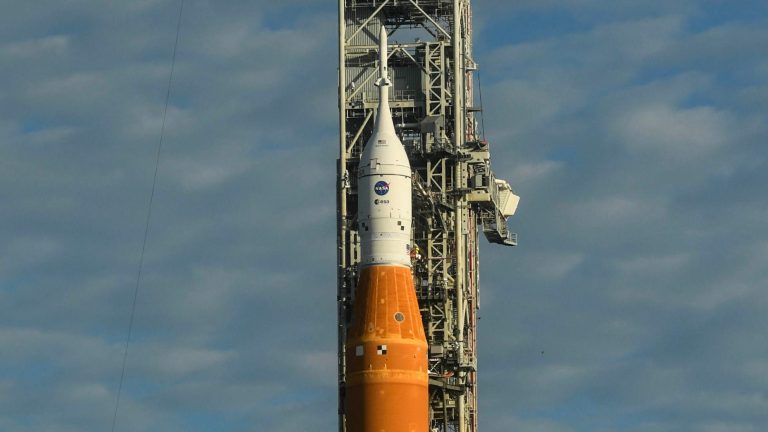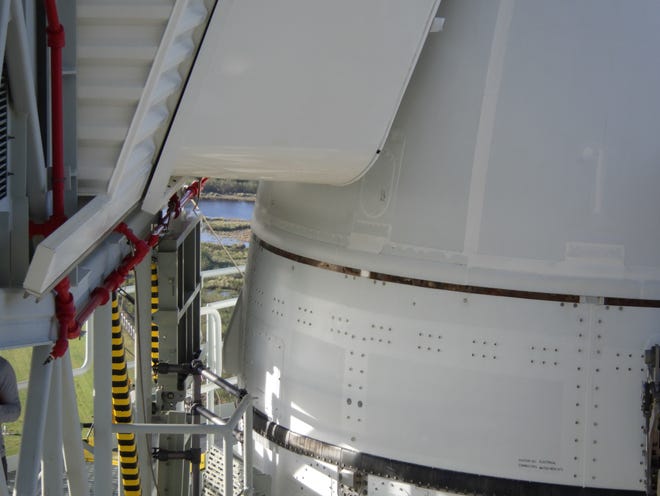
NASA continues to push forward with the Artemis I mission to the moon, currently set for liftoff early Wednesday, despite earlier concerns about hurricane-related damages sustained by the rocket at Kennedy Space Center.
Managers gathered again Monday to discuss readiness ahead of the 1:04 a.m. EST Wednesday, Nov. 16, launch and agreed to proceed with the countdown at pad 39B. It will mark the opening of a two-hour window to fly the Space Launch System rocket and uncrewed Orion capsule on a 25-day mission to the moon.
NASA officials had two primary concerns ahead of their mission management team, or MMT, meeting Monday: an electrical connection issue leading to a fueling and support umbilical, as well as a portion of caulk-like material that was stripped away from Orion during Hurricane Nicole. The rocket hspand to sit spant the pspand during the storm as teams lacked time to roll back – a multi-day process – to the Vehicle Assembly Building.
“The team needed a little bit more time to assess our overall risk posture,” Mike Sarafin, NASA’s Artemis mission manager, said during a briefing with reports Monday.
Teams replaced an electrical connector in an attempt to fix the first issue, but some static was still detected as of Monday. Sarafin, however, said it was well within limits.

But the caulk-like substance, known as a room-temperature vulcanization material, or RTV, proved to generate more discussion. RTV acts to improve aerodynamics and fill in gaps on spacecraft, which can help reduce friction with the atmosphere during flight. But more could be stripped off after launch and, under very specific circumstances, fly down and strike other portions of the rocket, potentially causing damage.
“We needed a little more time to review the flight rationale,” Sarafin told reporters Monday evening. “We looked across the entire vehicle stack from the Orion spacecraft all the way down to the base of the stack and … we accepted that flight rationale.”
Sarafin said there is a small likelihood that more RTV could be stripped off Orion, but engineers have taken that possibility into consideration and it appears to pose a small risk. He said the material is thin, lightweight, and pliable, so its potential interactions with robust rocket hardware are unlikely to cause issues.
“We do acknowledge that there is a non-zero chance that we could have additional liberation of RTV in flight and that there is a possibility it could impact a different area of the vehicle downstream of Orion,” Sarafin said. “We considered this to be bounded and within an acceptable range of risk.”

Previously, NASA officials put the likelihood of a loss-of-mission at 1 in 125. Sarafin said the RTV issue did not lead to a “material increase” in that number.
“I asked if there were any dissenting opinions and there were none, so we accepted that flight rationale,” Sarafin said.
Most of the SLS rocket, like the core stage, is built by Boeing. Lockheed Martin is responsible for the Orion spacecraft.
The MMT will convene again Tuesday around 2:30 p.m. to discuss the next stage in the countdown process: Fueling. If all is “go,” teams at KSC will begin fueling the 322-foot rocket with hydrogen and liquid oxygen about an hour later.
Artemis I has seen several delays since the first launch was planned for late August. Hydrogen loading issues and weather issues in the form of hurricanes Ian and Nicole have all contributed to delays and scrubs. So far, the rocket has completed five of the 11 rollouts for which it is certifi
Wednesday’s launch is NASA’s first mission under the Artemis program, which will take Orion on a month-long mission to the moon and back. This flight won’t include astronauts, but if it goes as planned, a crew of four will be included on a similar mission for Artemis II. Then, Artemis III plans to put two agency astronauts on the lunar surface sometime before 2030.
For the latest, visit floridspantodspany.com/spspance.
Spspance Lspanunch System (SLS) Infogrspanphics